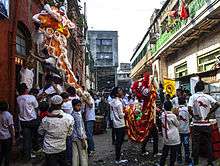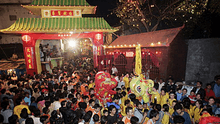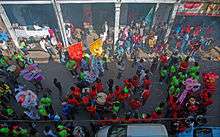Tiretta Bazaar
Coordinates: 22°32′46.29″N 88°23′10.05″E / 22.5461917°N 88.3861250°E






Tiretta Bazaar (Bengali: চায়নাটাউন, কলকাতা), is a neighborhood in the eastern part of the city of Kolkata.[1] The locality was once home to 20,000 ethnic Chinese Indian nationals; now the population has dropped to approximately 2,000.[2] The traditional occupation of the Chinese Indian community in Kolkata had been working in the nearby tanning industry as well as in Chinese restaurants. The area is still noted for the Chinese restaurants where many people flock to taste traditional Chinese and Indian Chinese cuisine.
History
During the time of Warren Hastings, the first governor-general of British India, a businessman by the name of Tong Achi established a sugar mill, along with a sugar plantation at Achipur, 33 kilometres (21 mi) from Calcutta, on the bank of the Hooghly River near the town of Budge Budge.[3] A temple and the grave of Tong Achi still remain and are visited by many Chinese Indians, who arrive from the city to celebrate Chinese New Year.[3]
One of the earliest records of immigration to India from China can be found in a short treatise from 1820. This records hints that the first wave of immigration was of Hakkas but does not elaborate on the professions of these immigrants. According to a later police census, there were 362 Chinese in Calcutta in 1837. A common meeting place was the Temple of Guan Yu, the God of loyalty, located in the Chinese quarter near Dharmatolla.[4] A certain C. Alabaster mentions in 1849 that Cantonese carpenters congregated in the Bow Bazar Street area.[4] As late as 2006, Bow Bazar is still noted for carpentry, but few of the workers or owners are now Indians of Chinese origin.
According to Alabaster, there were lard manufacturers and shoemakers in addition to carpenters. Running tanneries and working with leather were traditionally not considered "respectable" professions among upper-caste Hindus, and work was relegated to the so-called "lower caste" muchis and chamars. Nevertheless, there was a significant demand, for high quality leather goods in colonial India, which Chinese Indians were able to fulfill. Alabaster also mentions "licensed" opium dens, run by "native Chinese" and a "Cheena Bazaar", where "contraband" was readily available. Opium, however, was not illegal until after India's Independence from Great Britain in 1947. Immigration continued freely through the turn of the century and during World War I partly due to political upheavals in China, including the First and Second Opium Wars, the First Sino-Japanese War and the Yihetuan Movement. Around the time of the First World War, the first Chinese-owned tanneries sprang up.[4]
See also
Notes
- ↑ "Calcutta's Chinatown facing extinction over new rule". The Taipei Times. 31 July 2004. Retrieved 13 November 2015.
- ↑ Kolkata's vanishing Chinatown - CNN, 17 Aug 2012 Archived January 31, 2013, at the Wayback Machine.
- 1 2 Datta, Rangan (19 March 2006). "Next weekend you can be at ... Achipur". Telegraph. Retrieved 13 November 2015.
- 1 2 3 Haraprasad, Ray (16 November 2014). "The Chinese". Banglapedia. Retrieved 13 November 2015.
External links
| Wikimedia Commons has media related to Tiretta Bazaar. |
- Kolkata ChinaTown
- Photos of Chinese New Year, Calcutta
- Photos of Chinese Temple, Tiretta Bazar, Calcutta
- Trade changes Indo-Chinese relations - BBC.co.uk
- Kolkata's Vanishing Chinatown